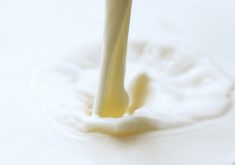I pondered whether to add more copy to the head-scratching and manufactured debate over palm fat in dairy nutrition and the subsequent effects on butter hardness, but I think the recent flurry of mainstream media coverage provides some lessons.
To recap:
Food sector pot stirrer Sylvain Charlebois of Dalhousie University is a master at bringing issues into the media spotlight. He’s authoritative and articulate and as such is a good interview for media, both in TV and in print.
Read Also

Ontario’s agri-food sector sets sights on future with Agri-Food 2050 initiative
The first-ever Agri Food 2050, a one-day industry event dedicated to envisioning the future of food and farming in Ontario,…
Most of this started by an online poll Charlebois posed in which half of the respondents agreed that it seemed like their butter was harder.
It must be noted that Charlebois, an economist, is a noted opponent of supply management in its current form.
He usually comes to an issue armed with data, as his group at Dalhousie does some excellent research on food trends.
But in this case, I’ve yet to see any data, other than a Twitter poll, that anyone is particularly concerned that their butter might be a slim percentage harder.
Others in addition to Charlebois have noticed as more people return to baking with butter.
It makes sense that butter will be harder when the feeding of palm fat is so prevalent on dairy farms, especially in Western Canada.
We know that fatty acids have an effect on dairy end products. A big effort once went into boosting the levels of Omega 3 fatty acids in milk.
Anyone who grew up on a dairy farm knows that there are subtle changes in milk composition based on feed and seasons. The butter has always been harder on the counter in the winter. There’s actually less variability now as dairy cattle are fed more consistent rations than they once were.
What bugs me is that none of this is new. Farmers have used palm fat in dairy rations for decades and it’s common around the world. This is not a Canadian issue. It’s also not just a dairy issue as one of the major sources of palm oil products in diets is butter-alternative margarine.
The margarine in our house is billed as “olive oil” margarine, but the volume of olive oil in the product is less than the volume of palm oil. I don’t see anyone exposing the margarine industry for mislabeling their palm oil margarine as olive oil margarine.
So is it fair to pick on dairy?
Butter is a cherished product with specific qualities that have made it work beautifully in pastry and baking and messing with that raises attention.
But there’s no doubt, this was a manufactured “crisis” by anti-supply management activists. Charlebois was on many TV programs and then followed that all up with a column that questions the “social contract” of the dairy sector with Canadian consumers.
The unwritten social contract is that dairy farmers supply the market with cost-effective, high-quality products in return for stable pricing.
Canadian butter remains high quality as it always has been, albeit with a slightly different melting point, similar to most of the rest of the butter in the world. The use of palm fat means about five per cent fewer cows are needed, which reduces the environmental impact of dairy, according to a balanced report on the issue in The Globe and Mail.
Using palm fat also helps keep the price of dairy products down.
The use of palm fat is common in all competing markets, so tearing down the walls of supply management would mean the need for more imports – from countries that also use palm fat.
Decreasing the use of palm oil derivatives in dairy rations is a laudable goal. It will reduce environmental impact at source (native forests are destroyed to grow palm plantations in Asia) and a return to expected melting points for bakers.
But it also will have an increased environmental impact due to the increased need for dairy cows, and costs to consumers could increase due to lower efficiency in the dairy system.
It’s never as black and white as activists make an issue seem and this issue is a good example of the ability of people with an agenda to use their developed megaphone to their advantage.















